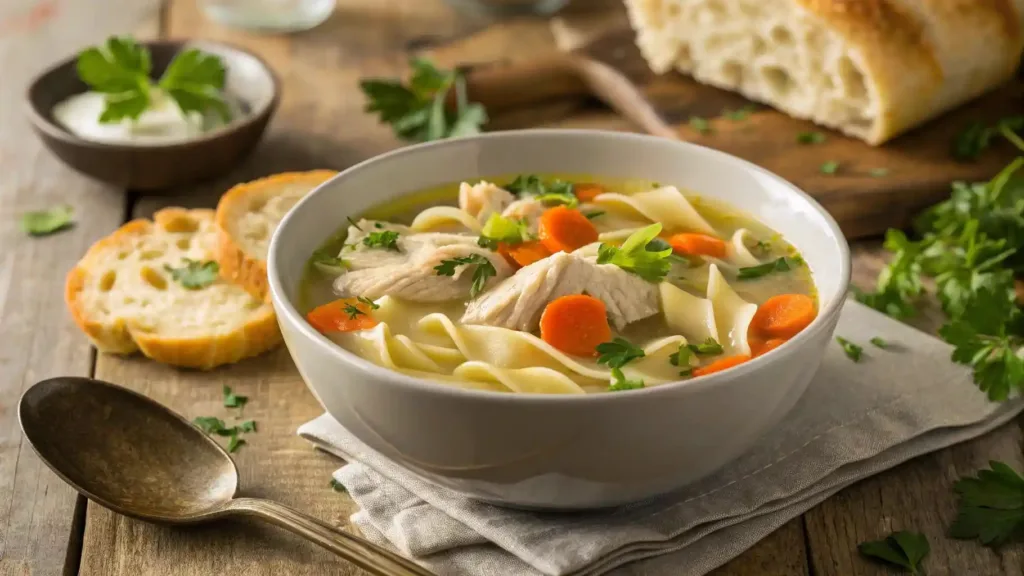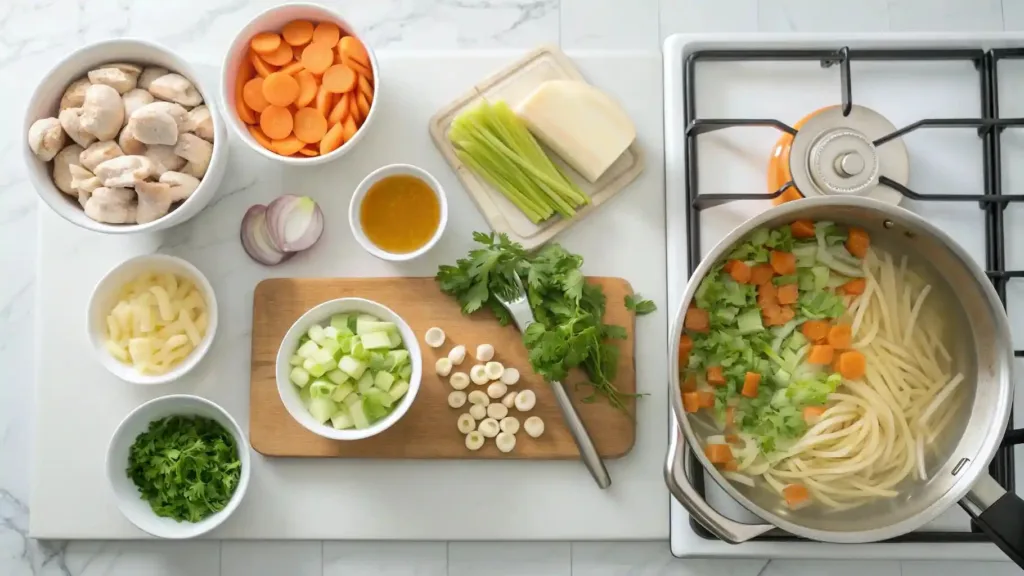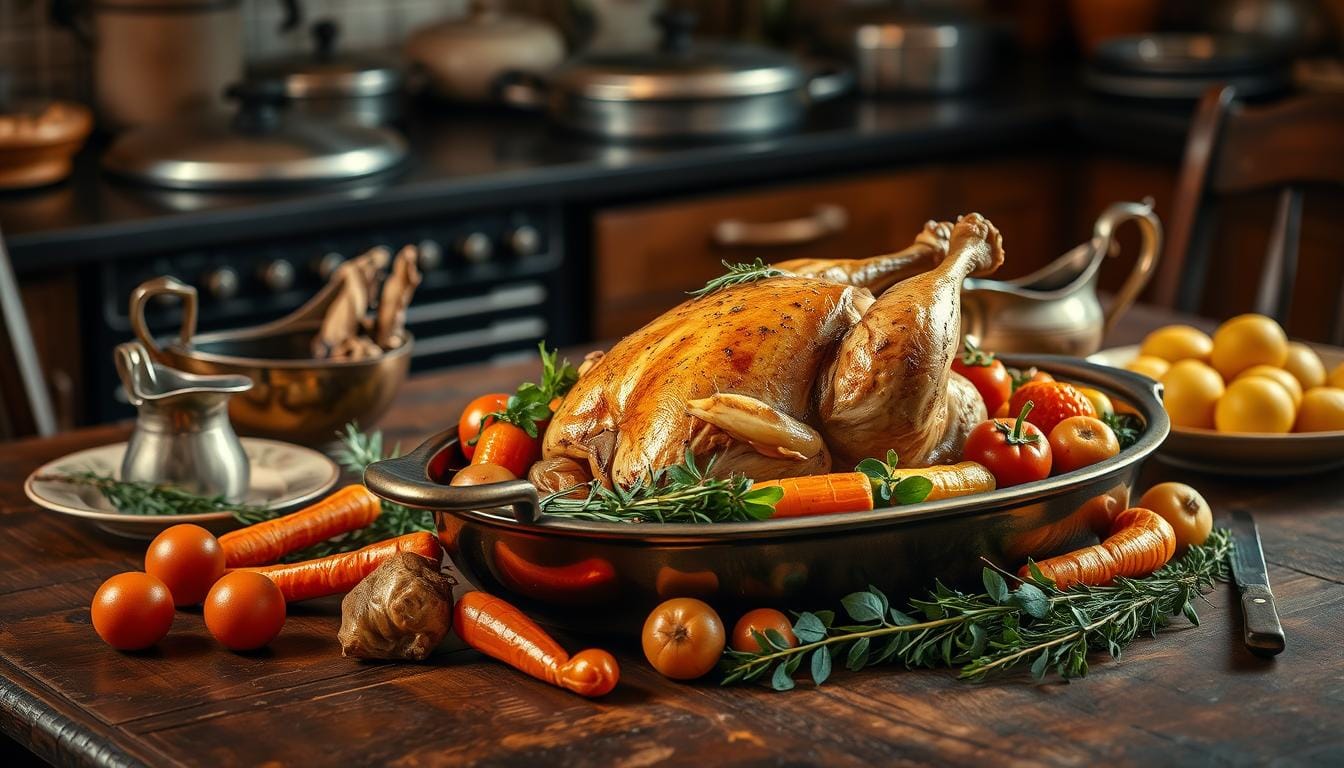There is a good reason why chicken noodle soup feels like much more than just a regular meal; it is an emotion. It is the warmth of a gentle hug on a cold day, the caring reassurance from a loved one when you are feeling under the weather, and the familiar flavor of childhood memories.
For many of us, the delightful aroma of a simmering broth, with its tender chicken and soft noodles, evokes feelings of cozy kitchens and nurturing hands.

This is not just about a recipe; it is a heartfelt tribute to that cherished, timeless tradition.
We will embark on a journey to uncover the secrets to making the perfect bowl of this classic comfort food, exploring everything from the freshest ingredients to the time-honored techniques that make it so very special. Your own ultimate guide to a perfect chicken noodle soup starts here.
The Foundation: Crafting the Perfect Broth
The true soul of any great chicken noodle soup resides in its broth. While store-bought options are convenient, creating your own broth from scratch elevates the flavor profile to an entirely new dimension. Think of a homemade broth as a blank canvas, ready to absorb the rich, complex flavors of your chosen ingredients. The difference is not subtle; it is a profound enhancement that will make your soup stand out.
The Magic of a Homemade Chicken Broth
To create a truly exceptional broth, you must begin with a foundation of quality. This is a deliberate, patient process that rewards you with an incredibly rich, savory liquid.
Ingredients for Your Liquid Gold
Your journey to a better broth begins with the right components. You will need:
- Chicken: A whole chicken carcass or a collection of bones (backs, necks, and wings) provides the most depth. You can often find these at your local butcher.
- Aromatic Vegetables: This classic trio, known as mirepoix, is the soul of your broth. Chop up carrots, celery, and yellow onions.
- Herbs and Spices: A bay leaf, a few sprigs of fresh thyme, and some whole black peppercorns will infuse your broth with subtle, earthy notes.
The Process: Building Flavor, Layer by Layer
Making broth is not a race; it is a slow, deliberate method. Follow these steps for an outstanding result:
- Roasting (Optional but Recommended): For a deeper, richer flavor, consider roasting your chicken bones and vegetables first. This caramelizes their natural sugars and creates a more complex taste profile.
- Sautéing: In a large stockpot, gently sauté your vegetables until they soften and become fragrant. This step helps release their essential oils and deepens their flavor.
- Simmering: Add your roasted bones, herbs, and spices to the pot. Cover everything with cold water. Bring the mixture to a slow, gentle simmer. Do not let it boil vigorously; a slow simmer allows the flavors to meld without making the broth cloudy.
- Skimming: As the broth heats, foam and impurities will rise to the surface. Use a large spoon to carefully skim this away. This simple step ensures your final broth is clear and pristine.
- Patience is a Virtue: Allow your broth to simmer for at least 3-4 hours, or even longer for a more intense flavor. The longer it simmers, the more nutrients and flavor it extracts from the bones.
A homemade chicken broth is more than just flavorful; it is also highly nutritious. Research has shown that the process of simmering bones extracts collagen, amino acids, and minerals like calcium and magnesium. It is believed that this nutritional profile supports your gut health and can aid in overall wellness. When you feel unwell, a bowl of this nutrient-dense liquid can be incredibly restorative.
Building the Bowl: Ingredients and Technique

With your golden broth prepared, you are ready for the next phase: adding the main components. This is where you get to decide on the textures and flavors that will define your unique chicken noodle soup.
Choosing Your Chicken: White Meat vs. Dark Meat
The chicken you choose will significantly impact the final texture and taste of your soup. Each cut offers a distinct experience.
- Boneless, Skinless Chicken Breast: If you are seeking a lean, quick-to-cook option, chicken breast is a great choice. It cooks quickly and shreds easily. However, be careful not to overcook it, as it can become dry.
- Chicken Thighs: For a richer, more succulent flavor, chicken thighs are an excellent selection. They are more forgiving to cook and remain moist, adding a beautiful richness to the soup.
- A Whole Chicken: This is the most traditional and arguably the best option. You can use the carcass for your broth and the meat for your soup. It provides a perfect balance of white and dark meat, offering a more complex flavor profile.
The Perfect Noodle: A Guide to Texture
The noodle is a crucial component of chicken noodle soup, and choosing the right one can prevent your soup from becoming a mushy disappointment. The key is to select a noodle that holds its shape and texture even after a good simmer.
- Egg Noodles: These are the classic choice for a reason. Their robust texture holds up well in a broth without dissolving.
- Orzo or Ditalini: For a heartier, more rustic soup, consider using small pasta shapes. They provide a different mouthfeel and are great for a thick, comforting bowl.
- Other options: Some people prefer to use gluten-free pasta, rice noodles, or even tortellini for a more luxurious twist.
Here is a pro tip that many seasoned cooks swear by: cook your noodles separately. You can simply cook a large batch of noodles and add them directly to each bowl of soup just before serving. This prevents the noodles from absorbing all the broth and becoming bloated and mushy, ensuring a perfect texture every time.
Vegetable Harmony: The Classic Trio and Beyond
The classic trio of carrots, celery, and onions is a non-negotiable part of any great chicken noodle soup. They are more than just fillers; they are essential for the soup’s flavor and a source of valuable nutrients.
- The Classic Trio: These three vegetables provide a delicate sweetness and a savory base that works beautifully with the chicken and broth.
- Optional Additions: Do not hesitate to experiment. A few slices of parsnip can add a subtle sweetness, while a handful of chopped potatoes can make your soup more hearty. For a boost of color and nutrients, consider adding some fresh spinach at the very end of cooking.
The Recipe and Variations
Now that you have all the components, it is time to bring everything together. This simple recipe provides a fantastic starting point, and from there, you can explore a world of creative possibilities.
Classic Chicken Noodle Soup Recipe
- Sauté the vegetables: In a large pot, sauté your chopped carrots, celery, and onions in a little olive oil or butter until they become tender and fragrant.
- Add the broth: Pour in your homemade chicken broth and bring it to a gentle simmer.
- Cook the chicken: Add your chosen chicken cut (thighs or breasts) to the simmering broth. Cook until the chicken is fully cooked through. This should only take about 15-20 minutes for breasts and slightly longer for thighs.
- Shred and return: Remove the chicken from the pot and use two forks to shred it. Return the shredded chicken to the broth.
- Cook the noodles: Add your noodles directly to the soup (if you prefer this method) or cook them in a separate pot according to the package directions.
- Season and serve: Taste your soup and add salt and black pepper as needed. Add a handful of fresh parsley or dill for a burst of freshness.
International Twists on a Classic
The classic chicken noodle soup is comforting, but what if you want to explore new flavors? Here are a few global twists you can try.
- Asian-Inspired: Add a few slices of fresh ginger, some chopped garlic, a splash of soy sauce, and a touch of sesame oil to your broth. Use ramen or udon noodles instead of egg noodles. Garnish with chopped scallions and a sprinkle of toasted sesame seeds.
- Spicy Southwestern: To give your soup a fiery kick, introduce a little chili powder, cumin, and a pinch of cayenne pepper. Add some corn and black beans for extra substance. Serve with a dollop of sour cream, a squeeze of fresh lime juice, and a handful of chopped cilantro.
- Creamy Chicken Noodle Soup: For a richer, heartier soup, stir in a cup of milk, heavy cream, or coconut milk at the end of the cooking process. This creates a luxurious texture that is perfect for a cold evening.
Tips and Tricks for the Perfect Bowl
Creating a fantastic bowl of chicken noodle soup is about paying attention to the small details. These expert tips will help you perfect your recipe.
- Use Fresh Herbs: While dried herbs have their place, fresh herbs like parsley and dill can add a brightness and freshness to your soup that dried herbs simply cannot replicate.
- Season in Layers: Do not just add salt and pepper at the end. Season your broth as it simmers, then taste and adjust the seasoning after you have added the chicken and noodles. This ensures a balanced flavor throughout.
- Let It Rest: After you have finished cooking, turn off the heat and let the soup sit for 10-15 minutes. This allows the flavors to meld together, resulting in a more harmonious and delicious final product.
- Store Leftovers Properly: If you are planning on having leftovers, store your broth, vegetables, and chicken in one container and your noodles in a separate container. This keeps the noodles from absorbing all the liquid and becoming mushy.
Frequently Asked Questions (FAQ) about Chicken Noodle Soup
You probably have some questions about this beloved comfort food. Here are the answers to some common inquiries.
- Q: Can you make chicken noodle soup in a slow cooker?A: Yes, absolutely! A slow cooker is an excellent way to prepare chicken noodle soup. Simply add all the ingredients to the slow cooker and let it simmer on low for several hours. This “hands-off” method allows you to come home to a ready-made, delicious meal.
- Q: How long does homemade chicken noodle soup last in the fridge?A: When stored in an airtight container, homemade chicken noodle soup will last for 3 to 4 days in the refrigerator. You can also freeze it for up to 3 months.
- Q: What are the health benefits of chicken noodle soup?A: Chicken noodle soup is a fantastic choice when you are feeling unwell. The warm broth helps with hydration, the steam can help to clear congestion, and the tender vegetables provide essential vitamins and minerals. The combination of protein from the chicken and carbohydrates from the noodles provides a balanced source of energy.
Conclusion: The Timeless Comfort of a Simple Bowl
Making your own chicken noodle soup is a truly rewarding experience that goes far beyond the kitchen. It is a genuine act of care, a connection to a long-standing tradition of nurturing others and ourselves. Whether you are preparing it for a sick loved one, a hungry family, or simply for yourself on a quiet evening, each spoonful is a testament to the power of simple, wholesome food. So, go on, simmer that broth, chop those vegetables, and create a bowl of comfort that you will remember long after the last drop is gone.
What is your favorite memory associated with chicken noodle soup? Share your stories and tips in the comments below! We would love to hear from you.







